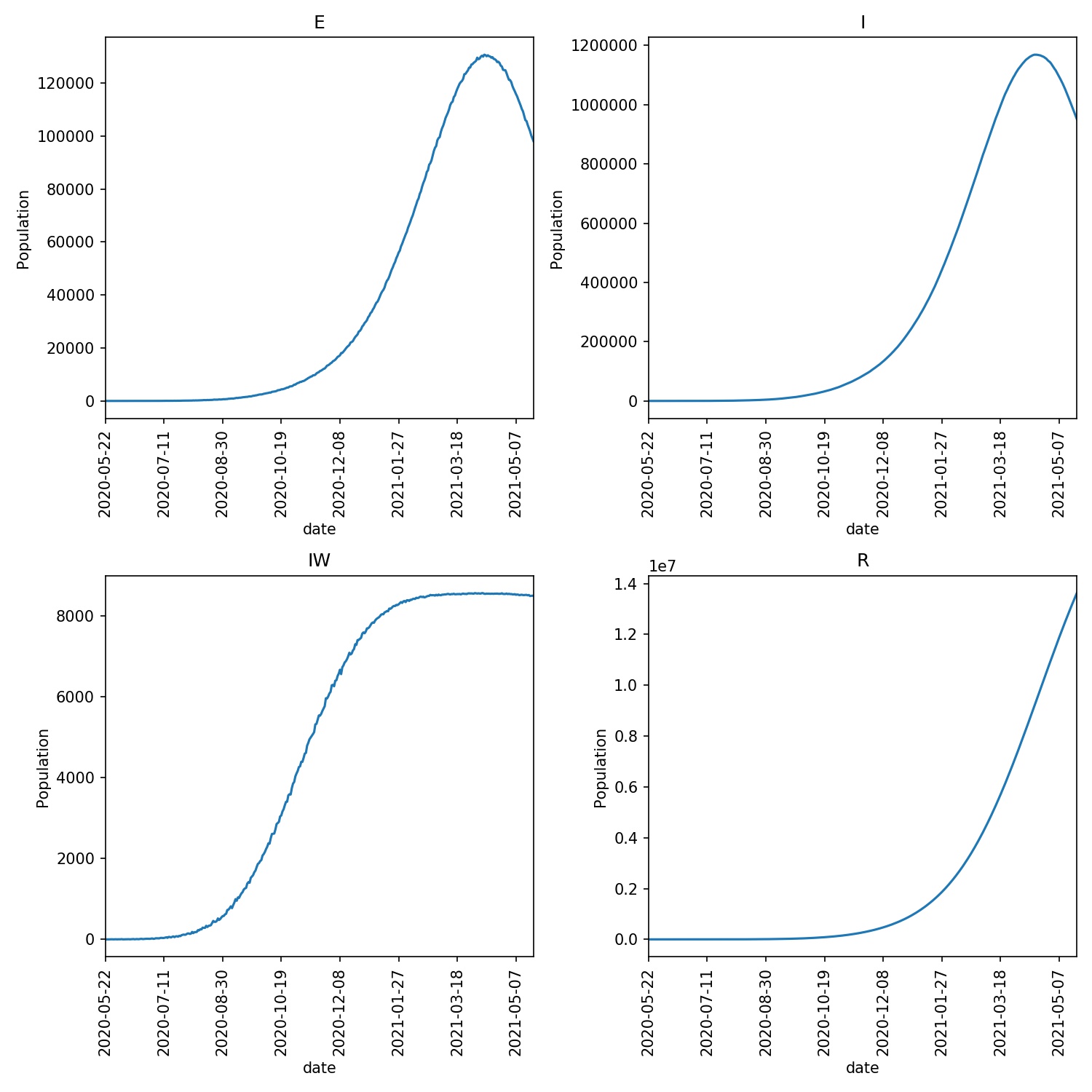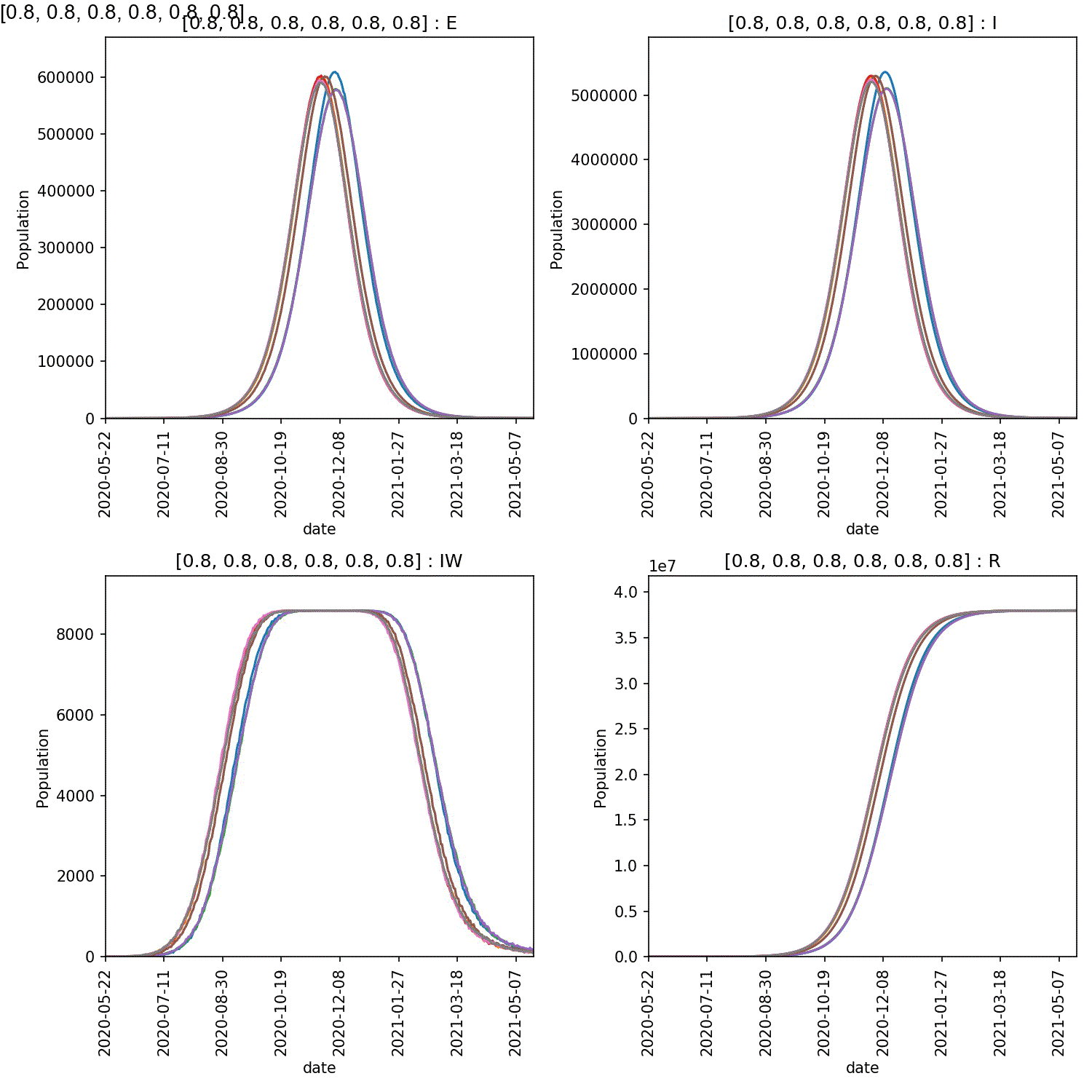Staying under quarantine
From the previous page, we saw that at least 90% of individuals needed to comply with self-isolation to limit the outbreak. However, that run assumed that everyone who entered self-isolation remained quarantined for the full seven days. It is important that we also model the impact of individuals breaking quarantine early.
go_early functions
We can represent a fraction of individuals
leaving quarantine early each day by passing the keyword
argument fraction to
go_to(). Do this by updating your
move_isolate.py to read;
from metawards import Population
from metawards import Networks
from metawards.movers import go_isolate, go_to
def move_isolate(network: Networks, population: Population, **kwargs):
user_params = network.params.user_params
ndays = 7
isolate_stage = 3
compliance_fraction = 0.9
# fraction who remain in isolation, counting from the longest to
# shortest stay in isolation.
remain = [0.9, 0.9, 0.95, 0.95, 1.00, 1.00]
day = population.day % 7
isolate = f"isolate_{day}"
go_early = []
# have to define this functions one-by-one and not in a loop
# otherwise python will bind all functions to the value of i
# of the last iteration of the loop
go_early.append(lambda **kwargs: go_to(
go_from=f"isolate_{(day + 1) % 7}",
go_to="released",
fraction=(1.0 - remain[0]),
**kwargs))
go_early.append(lambda **kwargs: go_to(
go_from=f"isolate_{(day + 2) % 7}",
go_to="released",
fraction=(1.0 - remain[1]),
**kwargs))
go_early.append(lambda **kwargs: go_to(
go_from=f"isolate_{(day + 3) % 7}",
go_to="released",
fraction=(1.0 - remain[2]),
**kwargs))
go_early.append(lambda **kwargs: go_to(
go_from=f"isolate_{(day + 4) % 7}",
go_to="released",
fraction=(1.0 - remain[3]),
**kwargs))
go_early.append(lambda **kwargs: go_to(
go_from=f"isolate_{(day + 5) % 7}",
go_to="released",
fraction=(1.0 - remain[4]),
**kwargs))
go_early.append(lambda **kwargs: go_to(
go_from=f"isolate_{(day + 6) % 7}",
go_to="released",
fraction=(1.0 - remain[5]),
**kwargs))
go_isolate_day = lambda **kwargs: go_isolate(
go_from="home",
go_to=isolate,
self_isolate_stage=isolate_stage,
fraction=compliance_fraction,
**kwargs)
go_released = lambda **kwargs: go_to(go_from=isolate,
go_to="released",
**kwargs)
return go_early + [go_released, go_isolate_day]
Note
It would be nicer and less error-prone if we could create the
go_early functions in a loop. However, this would not work
because of the way that Python lambda functions bind their arguments.
If we did this, the arguments from the last iteration of the loop
would be used for all of the go_early functions, i.e. we would
try to move individuals out of the same isolate_N demographic
six times.
Note
Note that we’ve set compliance to 0.9 based on the results of the
last scan.
Here, we’ve created a new set of go functions called go_release_early.
There is one for each isolate_N demographic except for the
demographic to which individuals will be moved on each day.
This go_release_early function moves a fraction of individuals from
the isolate_N demographic to released, representing that fraction
breaking their quarantine early. This fraction is taken from the list
remain, which counts up from 0.90 to 1.00. The first value
(0.90) is the fraction for individuals that have been isolating the longest
(six days), and that will remain in isolation that day (i.e. 90% will remain,
while 10% will break quarantine early). The last value (1.00) is the
fraction for the individuals who only entered isolation the previous day,
i.e. everyone remains in isolation for at least one day. These go_early
functions are then added before go_released and go_isolate_day.
Now run metawards using your move_isolate.py via;
metawards -d lurgy4 -D demographics.json -a ExtraSeedsLondon.dat --mixer mix_isolate --mover move_isolate --nsteps 365
You should see that the disease spreads, now both from individuals who choose not to self-isolate, and now also from individuals who break their quarantine early. Graphing the output via;
metawards-plot -i output/results.csv.bz2
gives an overview plot that should look something like;

It is clear that individuals who break quarantine early contribute significantly to further spread of the outbreak (> 14 million have experienced infection after one year in this model run compared to ~6 million if all individuals strictly observed the full seven days of quarantine).
Scanning quarantine
The next step is to scan through different compliance levels for
different numbers of days. To do this, update your
move_isolate.py to read;
from metawards import Population
from metawards import Networks
from metawards.movers import go_isolate, go_to
def move_isolate(network: Networks, population: Population, **kwargs):
user_params = network.params.user_params
ndays = 7
isolate_stage = 3
compliance_fraction = 0.9
# fraction who remain in isolation, counting from the longest to
# shortest stay in isolation.
remain = user_params["remain"]
day = population.day % 7
isolate = f"isolate_{day}"
go_early = []
# have to define this functions one-by-one and not in a loop
# otherwise python will bind all functions to the value of i
# of the last iteration of the loop
go_early.append(lambda **kwargs: go_to(
go_from=f"isolate_{(day + 1) % 7}",
go_to="released",
fraction=(1.0 - remain[0]),
**kwargs))
go_early.append(lambda **kwargs: go_to(
go_from=f"isolate_{(day + 2) % 7}",
go_to="released",
fraction=(1.0 - remain[1]),
**kwargs))
go_early.append(lambda **kwargs: go_to(
go_from=f"isolate_{(day + 3) % 7}",
go_to="released",
fraction=(1.0 - remain[2]),
**kwargs))
go_early.append(lambda **kwargs: go_to(
go_from=f"isolate_{(day + 4) % 7}",
go_to="released",
fraction=(1.0 - remain[3]),
**kwargs))
go_early.append(lambda **kwargs: go_to(
go_from=f"isolate_{(day + 5) % 7}",
go_to="released",
fraction=(1.0 - remain[4]),
**kwargs))
go_early.append(lambda **kwargs: go_to(
go_from=f"isolate_{(day + 6) % 7}",
go_to="released",
fraction=(1.0 - remain[5]),
**kwargs))
go_isolate_day = lambda **kwargs: go_isolate(
go_from="home",
go_to=isolate,
self_isolate_stage=isolate_stage,
fraction=compliance_fraction,
**kwargs)
go_released = lambda **kwargs: go_to(go_from=isolate,
go_to="released",
**kwargs)
return go_early + [go_released, go_isolate_day]
The only change is that we now read the remain list from the
custom user variable called remain.
Create a scan file called scan_remain.dat and copy in the below;
.remain[0] .remain[1] .remain[2] .remain[3] .remain[4] .remain[5]
1.00 1.00 1.00 1.00 1.00 1.00
0.95 1.00 1.00 1.00 1.00 1.00
0.95 0.95 1.00 1.00 1.00 1.00
0.95 0.95 0.95 1.00 1.00 1.00
0.95 0.95 0.95 0.95 1.00 1.00
0.95 0.95 0.95 0.95 0.95 1.00
0.95 0.95 0.95 0.95 0.95 0.95
0.90 0.95 0.95 0.95 0.95 0.95
0.90 0.90 0.95 0.95 0.95 0.95
0.90 0.90 0.90 0.95 0.95 0.95
0.90 0.90 0.90 0.90 0.95 0.95
0.90 0.90 0.90 0.90 0.90 0.95
0.90 0.90 0.90 0.90 0.90 0.90
0.85 0.90 0.90 0.90 0.90 0.90
0.85 0.85 0.90 0.90 0.90 0.90
0.85 0.85 0.85 0.90 0.90 0.90
0.85 0.85 0.85 0.85 0.90 0.90
0.85 0.85 0.85 0.85 0.85 0.90
0.85 0.85 0.85 0.85 0.85 0.85
0.80 0.85 0.85 0.85 0.85 0.85
0.80 0.80 0.85 0.85 0.85 0.85
0.80 0.80 0.80 0.85 0.85 0.85
0.80 0.80 0.80 0.80 0.85 0.85
0.80 0.80 0.80 0.80 0.80 0.85
0.80 0.80 0.80 0.80 0.80 0.80
This will scan the percentage of individuals who should remain in quarantine
each day from 1.00 (100%) to 0.80 (80%). It does this in increments
of 0.05, starting from the longest period of isolation (7 days) and moving
that to the shortest period (less than 1 day).
There are a large number of jobs, and repeats are needed to properly sample the outbreak. Here are job scripts to run this job on either a PBS or Slurm cluster;
#!/bin/bash
#PBS -l walltime=12:00:00
#PBS -l select=4:ncpus=64:mem=64GB
# The above sets 4 nodes with 64 cores each
source $HOME/envs/metawards/bin/activate
# change into the directory from which this job was submitted
cd $PBS_O_WORKDIR
metawards -d lurgy4 -D demographics.json -a ExtraSeedsLondon.dat \
--mixer mix_isolate --mover move_isolate --extractor extract_none \
--nsteps 365 -i scan_remain.dat --repeats 8 \
--nthreads 16 --force-overwrite-output --no-spinner --theme simple
#!/bin/bash
#SBATCH --time=01:00:00
#SBATCH --ntasks=4
#SBATCH --cpus-per-task=64
# The above sets 4 nodes with 64 cores each
source $HOME/envs/metawards/bin/activate
metawards -d lurgy4 -D demographics.json -a ExtraSeedsLondon.dat \
--mixer mix_isolate --mover move_isolate --extractor extract_none \
--nsteps 365 -i scan_remain.dat --repeats 8 \
--nthreads 16 --force-overwrite-output --no-spinner --theme simple
Analysis
Once you have run the jobs, you can generate the animation of the overview plots using;
metawards-plot -i output/results.csv.bz2
metawards-plot --animate output/overview*
You should get an animation that looks something like this;

Reflections on results
Again, it is clear that self-isolation only works well if there is very high compliance with remaining in quarantine for the full seven days. As 5% of people break quarantine after 2-3 days, the size of the outbreak grows from ~6 million to ~15 million. This grows to >20 million if 10% break quarantine.
All of these results suggest that, for the lurgy, that self-isolation and quarantine are only effective strategies if;
they start as quickly as possible once an individual is infectious (which may be difficult due to the early stage of the lurgy being largely asymptomatic - track and trace systems would likely need to be used and be extremely fast and effective),
are observed by the vast majority (>90%) of infected individuals, and
>95% of individuals remain in quarantine for the full seven days.
As noted at the start of this tutorial, the lurgy is not a serious disease, so would not warrant the level of social control needed to achieve these three requirements (and, indeed, a population that does not perceive the lurgy to be serious would be unlikely to comply to the level needed).
This should not be surprising given where each model run starts - just five infected individuals in one ward. Any disease that is so contagious that an infection in such a small group of individuals grows quickly into a widespread outbreak will always be very difficult to control.